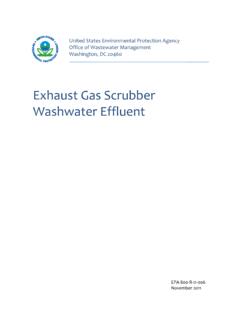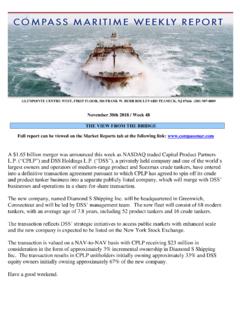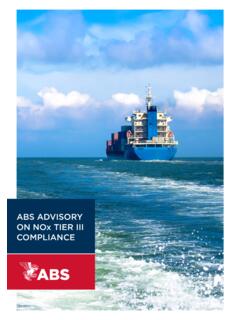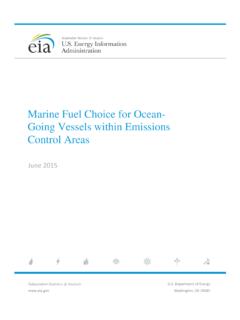Transcription of Comparison of Alternative Marine Fuels - SEA-LNG
1 Comparison of Alternative Marine Fuels SEA\LNG Ltd Report No.: 2019-0567, Rev. 4. Document No.: 11C8I1KZ-1. Date: 2019-09-25. Project name: Alternative Marine Fuels study DNV GL AS Maritime Report title: Comparison of Alternative Marine Fuels Environment Advisory Customer: SEA\LNG Ltd Veritasveien 1. Customer contact: Steve Esau 1363 H vik Date of issue: 2019-09-25 Norway Project No.: 1-1C8I1KZ Tel: +47 40223162. Organisation unit: Environment Advisory Report No.: 2019-0567 Rev. 4. Document No.: 11C8I1KZ-1. Objective: To assess the commercial and operational viability of Alternative Marine Fuels , based on existing academic and industry literature. The approach assesses how well selected Alternative Fuels perform compared to LNG fuel. The Alternative Fuels included are hydrogen, ammonia, methanol, LPG, advanced biodiesel (hydrotreated vegetable oil - HVO) and electricity (batteries).
2 Prepared by: Verified by: Approved by: Jon Anders Ryste Martin Wold Terje Sverud Senior Consultant Senior Consultant Head of section Martin Wold, Joakim Frimann-Dahl, Christos Chryssakis, Magnus S. Eide, yvind Endresen, H kon Hustad Copyright DNV GL 2019. All rights reserved. Unless otherwise agreed in writing: (i) This publication or parts thereof may not be copied, reproduced or transmitted in any form, or by any means, whether digitally or otherwise; (ii) The content of this publication shall be kept confidential by the customer; (iii) No third party may rely on its contents; and (iv) DNV GL undertakes no duty of care toward any third party. Reference to part of this publication which may lead to misinterpretation is prohibited. DNV GL and the Horizon Graphic are trademarks of DNV GL AS. DNV GL Distribution: Keywords: OPEN.
3 Unrestricted distribution, internal and external. Alternative Marine Fuels INTERNAL use only. Internal DNV GL document. SEA\LNG. CONFIDENTIAL. Distribution within DNV GL according to applicable contract.*. SECRET. Authorized access only. *Specify distribution: SEA\LNG. Rev. No. Date Reason for Issue Prepared by Verified by Approved by 0 2019-05-15 First draft to client JAR MAWOL. 1 2019-05-29 Second draft to client JAR MAWOL. 2 2019-06-28 Final draft JAR MAWOL TSV. 3 2019-07-05 Final report JAR MAWOL TSV. 4 2019-09-25 New revision, minor changes JAR MAWOL TSV. DNV GL Report No. 2019-0567, Rev. 4 Page i Table of contents ABBREVIATIONS .. 3. 1 EXECUTIVE SUMMARY .. 4. 2 GOALS OF STUDY .. 11. 3 INTRODUCTION .. 11. 4 METHODOLOGY .. 13. Step 1: Selecting pathways 13. Step 2: Establishing a literature database 15. Assessment parameters 16.
4 Step 3: Categorizing database and selecting the most relevant papers and studies 16. Step 4: Data extraction 17. Step 5: Results and conclusions 17. 5 PATHWAY DESCRIPTIONS .. 18. Converters for multiple fuel pathways fuel cells and combustion engines 18. Fuel cells 18. Internal combustion engines 18. LNG pathways 19. Hydrogen pathways 20. Ammonia pathways 21. Methanol pathway 23. LPG pathway 24. Advanced biodiesel pathway 25. Fully electric pathway 25. Summary of pathways 27. 6 DATA EXTRACTION AND RESULT ASSESSMENT .. 28. Applicability 28. Energy density 28. Flammability and toxicity 29. Technological maturity 31. International regulations and class rules 32. Economics 34. Energy cost 34. Capital costs 36. Environment 39. Well-to-wake GHG emissions 39. Local emissions - SOx, NOx and PM 41. Scalability 43. Main current usages 43.
5 Availability 45. Global production capacity and locations 48. 7 CONCLUSIONS AND KEY FINDINGS .. 51. 8 REFERENCES .. 55. APPENDIX A INPUT TO CALCULATIONS .. 60. APPENDIX B SOURCES USED FOR ASSESSMENT OF EACH PARAMETER .. 61. DNV GL Report No. 2019-0567, Rev. 4 Page ii ABBREVIATIONS. ICE Internal Combustion Engine FC Fuel Cell CH3OH / MeOH Methanol NH3 - Ammonia H2 - Hydrogen NG Natural Gas LPG Liquefied Petroleum Gas HFO Heavy Fuel Oil HVO Hydrotreated Vegetable Oil MGO Marine Gas Oil BMS Battery Management System DNV GL Report No. 2019-0567, Rev. 4 Page 3. 1 EXECUTIVE SUMMARY. The overall ambition of the study has been to assess the commercial and operational viability of Alternative Marine Fuels , based on review existing academic and industry literature. The approach assesses how well six Alternative Fuels perform compared to LNG fuel on a set of 11 key parameters.
6 Conventional Fuels are not covered in this study, however 2020 compliant Fuels (HFO+ scrubber and low sulphur Fuels are included in the conclusion for comparative purposes. The methodology applied in this study is a five-step process. First, 16 pathways from energy source to fuel to on board energy converter ( engine ) were established (step 1). Then, a comprehensive literature search was performed to assemble a wide range of literature relevant for the selected pathways and the 11 assessment parameters defined in the project scope (step 2). Through a categorization and evaluation process the most relevant references were selected (step 3). In the data extraction phase (step 4), values for the key assessment parameters were collected, converted to a common unit for Comparison and visualized in graphs, illustrating minimum to maximum ranges and average values.)
7 Lastly, the results for each pathway were evaluated and compared (step 5). The result of step 1-5 was an assessment based on identifying, summarizing and presenting objective findings based on existing literature on the topic of Alternative Fuels . Certain general conclusions can be drawn when looking at the parameters highlighted as highest priority , namely fundamental features, barriers and other aspects which will have a significant impact on the future uptake. Such features can often be translated back to cost (the business case) or technical feasibility. Below key graphs comparing the performance of the assessed Fuels and technologies are shown. Energy density: The energy density of a fuel partly determines how applicable the fuel is for certain ship types and ship operations. Because of its low volumetric and gravimetric densities, employing batteries to propel deep-sea operation is challenging and for most cases simply not feasible/realistic.
8 LNG has around 40 % lower volumetric energy density than diesel, roughly the same as LPG. When accounting for the storage system, LNG has roughly 1/3 the volumetric energy density as diesel. Liquid hydrogen, ammonia and methanol have even lower volumetric energy density around 40-50 % of LNG. Biodiesel is the only fuel which is close to matching the energy density of diesel. Figure 1-1: Energy densities for different energy carriers (inspired by /49/ /72/ and /73/). The arrows represent the impact on density when taking into account the storage systems for the different types of fuel (indicative values only). DNV GL Report No. 2019-0567, Rev. 4 Page 4. Energy cost: It is clear that LNG, methanol and LPG are competitive in terms of energy costs, while HVO is significantly more expensive. Hydrogen and ammonia are also far more expensive, and the large cost range indicates a significant uncertainty in terms of pricing.
9 In addition, the distribution cost and mark-up is not included for hydrogen, ammonia and HVO in the figure below. Figure 1-2: Energy cost for the fuel/technology pathways, taking into account the energy content and system efficiency [USD/MWh shaft output]. Capital cost: The additional capital costs for using Alternative Fuels primarily comprise of the converter cost, storage tank cost and any necessary processing systems. This report has focused on the converter and storage tank costs. When assessing converter costs, it is evident that fuel cells are currently many times more expensive than internal combustion engines. Moreover, the big range in cost for Fuels cells indicates a large degree of uncertainty. Fuel cells also have a significantly shorter life expectancy than internal combustion engines, and fuel cell stack replacement is expected several times during a vessel's lifetime, leading to additional capital costs.
10 When comparing storage tank costs the converter efficiency, tank storage utilization factor and storage lifetime have been considered. The cost for storage tanks for methanol and HVO are the lowest while LNG tank costs vary slightly depending on efficiency of converter. For hydrogen DNV GL have found tanks for liquefied hydrogen to be significantly more expensive due to lower storage temperatures, higher insulation quality and fewer maritime applications. For LPG, DNV GL have found the cost of installing LPG systems on board a vessel to be roughly half that of an LNG system if pressurized type C. DNV GL Report No. 2019-0567, Rev. 4 Page 5. tanks are used in both cases. Although there is no available data for ammonia, the storage tank costs are expected to be at the same level as that of LPG, considering both Fuels are stored under similar conditions.







